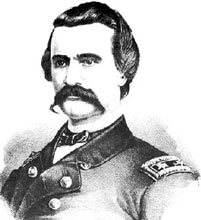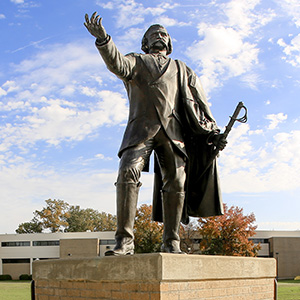A Brief Biography of General John A. Logan
John A. Logan, the man after whom John A. Logan College is named, was born February 9, 1826, in what is now Murphysboro, Illinois. Raised in a home that was a center of political activity, he came to love politics at an early age.
In 1840 his father, Dr. John Logan, sent him to Shiloh Academy at Shiloh Hill, Illinois, to complete his education. Here Logan excelled in oratory.
Logan volunteered for the Mexican War in 1846. He saw no combat, but did travel to Santa Fe, where he served as post quartermaster and learned Spanish.
The 1850’s brought may changes in Logan’s life — law school at Louisville University; marriage to Mary S. Cunningham at Shawneetown; a move to Benton; and a political career that led from county clerk to U.S. Congressman. In Southern Illinois, he was “Egypt’s spokesman.”
At the onset of the Civil War, the formerly pro–Southern Logan decided that “the union must prevail.” He fought at Bull Run as a civilian. He then returned home where his speech at Marion ended Egypt’s talk of secession and put southern Illinois during the Civil War strongly in the Union camp.
Logan volunteered for the war and rose from colonel to major general. Fighting in eight major campaigns, he distinguised himself at Vicksburg and commanded the entire Union forces at the Battle of Atlanta. At the war’s end, he saved Raleigh, North Carolina, from being burned by angry Union troops. Many historians consider him the premier volunteer general of the Civl War.
After the war, Logan returned to Congress. His concern for veterans led him to take part in Illinois’ first organized veterans memorial services at Woodlawn Cemetery in Carbondale in 1866. In 1868, he helped found Memorial Day as a national holiday.
In 1871 and again in 1874, Logan was elected to the U.S. Senate. Throughout his political career, he was a strong advocate for public education. In 1884, he was James G. Blaines’ vice-presidential running mate. During the campaign, Logan commissioned the painting that became the center for Atlanta’s famed Cyclorama.
John A. Logan died December 26, 1886, in Washington D.C., where he lies buried in Soldier Cemetery.
Logan’s fame did not die with him as the towns and counties named for him show. Fine equestrian statues were erected in Chicago and Washington in his honor. Bronze plaques from Arlington Cemetery to Denver attest to his role in establishing of Memorial Day. Yet the turmoil of the mid–twentieth century saw Logan’s fame fade. In May, 1986, the Washington Post wrote that this was “pretty shoddy treatment” for the man who founded Memorial Day.
In 2002, John A. Logan College erected a statue of Logan at the center of campus (photo on left). Logan is shown in the summer of 1865 as he sets aside his sword, and two-star general’s coat and becomes a man of peace.
Logan’s Education Speech
As a U.S. senator, John A. Logan was instrumental in bringing a public awareness of the need for support of education. Click here for the text of his 1882 speech.
Logan’s Order Mandating Memorial Day
Click here for the entire text of the order that mandated Memorial Day
Other John A. Logan links

